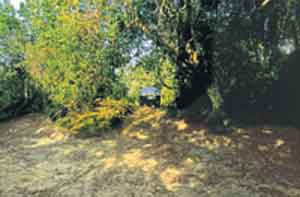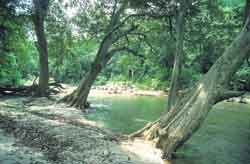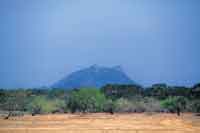|
|
||||||||
|
Yala road at crossroads
Wildlife lovers and conservationists have voiced serious concerns over a decision by the Road Development Authority (RDA) to develop a road through the Ruhuna (Yala) and Kumana National Parks. Such development would have damaging effects on the wild life and habitat of these protected areas, they say.
The proposal to develop the road from Kirinda to Pottuvil- most of which is a dirt track that lies within the boundaries of the National Parks - was put to President Mahinda Rajapaksa by the Chairman of the RDA, M.B.S. Fernando. This was after the RDA Chairman made a personal visit to the Yala National Park during which the poor condition of the road was brought to his notice. Having received the President’s approval to undertake this project, the Chairman and other officials from the RDA had inspected the road earlier this year to examine the possibility of converting the gravel stretches and jeep-tracks to a road that would be accessible in all weather conditions. The approximate length of the road is 30 km. The road — which would cover Yala Blocks 1 and 2 and traverse Kumbukkan Oya, Okanda and Kumana going up to Pottuvil and Panama — would be under the control of the Department of Wildlife Conservation. Future maintenance of the road would also be handed over by the RDA to the DWLC providing their officials the necessary equipment and training. Mr. Fernando says that the renovations were taking place purely for tourism purposes to increase the tourism revenue to the country. By developing the existing road, they hoped to make previously inaccessible areas accessible to the public, thereby increasing the number of visitors to the Yala park.
The Yala National Park is the largest continuous
protected forest area in the country and plays a significant role
in the conservation of the country’s flora and fauna. Rich
in its diversity of habitat and animals, it is known for elephant,
leopard, crocodile and deer. There are also many sites of historical
and archaeological value within the park. Despite the concerns of environmentalists, Director of the Department of Wildlife Conservation Dayananda Kariyawasam affirmed that he was in favour of the road since it had been agreed that it would be a gravel road, constructed in an environmentally friendly manner. No one would be able to enter the park without a ticket and a tracker, and all those using the road would have to follow the existing park rules, not travelling at high speeds, etc., he said. The road would be closed after 6 p.m. and careful records would be maintained at the entry and exit points.
Mr. Kariyawasam said that the road would enable the Department to prevent illegal activities such as poaching and gem mining by giving officials better access to certain areas of the park. However, conservationists feel that the threat posed to the wild animals by such developments far outweigh any benefits. Rather than preventing illegal activities they point out that there will probably be an increase in poachers, illicit loggers and other such persons gaining easier access to various regions of the park by means of the roadway. Wildlife photographer and environmentalist Namal Kamalgoda, remarking on the severe shortage of staff in the Wildlife Department said that at present there were not enough trackers even to accompany individual vehicles through the park during the weekends. In that case, he questioned, how would they cope with increased traffic, and moreover, how could they expect to police the road thoroughly to prevent poaching? The chief concern for most conservationists is whether the road is going to be a public access road, and be utilized for the purpose of conveniently getting from one point to another rather than for visiting the park. Mr. Kariyawasam said that he had not given thought to that aspect, adding that it was too early to tell. He admitted that there would have to be some restrictions imposed. RDA Chairman Fernando however, said that as long as they were provided with a ticket and a guide, anyone could access the road with the permission of the Department. A road in a National Park should not be used for purposes that are not in the interests of the park, say conservationists. If there is a main road going through the park, there maybe traffic during times when the park is usually closed to visitors to give respite to the animals, such as at times of severe drought. Conservationist and lawyer specialising in environmental issues Jagath Gunawardane stresses that the country’s natural resources cannot be sacrificed for tourism purposes. “Renovations of this nature would cause ‘the Edge Effect’- which will take place alongside the new road and the extent to which it would spread are uncertain. The road would act as a physical and biological barrier, dividing the park into two,” he said. He also pointed out that a gravel road would require constant maintenance, which would further disturb the animals, and therefore cannot be called ‘environmentally friendly’. Road-kills, which were common even with the existing road, would undoubtedly increase despite it not being a high-speed road, said Mr. Gunawardane, commenting on the frequent deaths of small mammals, lizards and mongooses after being hit by a moving vehicle. World Bank environmental specialist Sumith Pilapitiya cautioned thatSri Lanka had to be particularly careful when destroying or damaging the environment, since it directly affected the country’s economic growth. A report by the Yale University in USA-The 2005 Environmental Sustainability Index -had shown Sri Lanka’s economic growth as not environmentally sustainable. Mr. Pilapitiya also pointed out that the existing track partly lay through the Yala Strict Natural Reserve (SNR), which is a key bio-diversity area that can only be entered for research purposes. Of the three SNRs in Sri Lanka, the one in Yala is the most highly protected, and should not be open to visitation, he said. He advised that an informed decision should be made only after conducting an EIA to gain an understanding of the issue. When asked if the road would be used for military purposes, the RDA Chairman stated that it would be used only for emergencies - by enabling security personnel to move quickly into strategic locations in the road from Palatupana to Okanda (the entrance and exit points of the Yala National Park) in an emergency. The RDA will conduct an Environmental Impact Assessment (EIA) before starting operations in response to a request made by the DWLC Director. Although an estimate has not been done, the RDA Chairman believes the road project would cost approximately Rs. 100 million. If the project receives an allocation in the Budget of 2007, he says, the RDA hopes to complete it by the end of next year
|
||||||||
Copyright © 2006 Wijeya Newspapers
Ltd. All rights reserved. |


